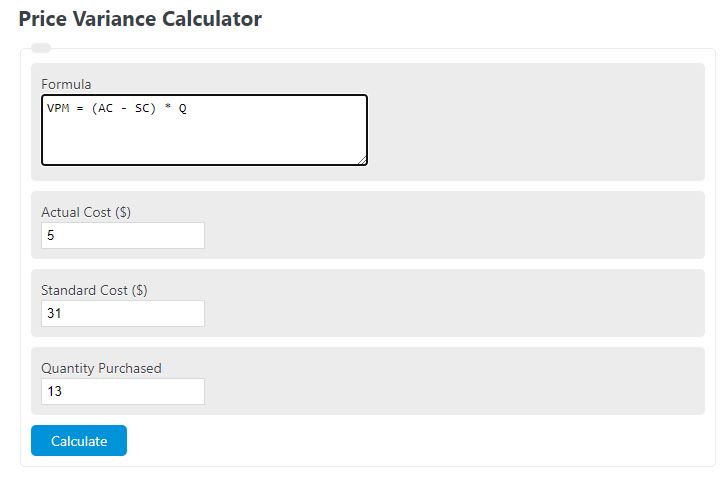Enter the actual unit cost, standard unit cost, and the actual quantity purchased into the calculator to determine the price variance.
Price Variance Formula
The following formula is used to calculate a price variance of a material.
VPM = (AC - SC) * Q
- Where VPM is the price variance
- AC is the actual unit cost
- SC is the standard cost
- Q is the quantity purchased
Actual unit cost refers to the total cost incurred to produce a single unit of a product or service, considering all direct and indirect costs.
Standard cost is a predetermined cost that is used as a basis for evaluating actual costs and performance in a business.
The quantity purchased refers to the amount of a product or service that is bought by a consumer.
Price Variance Definition
The price variance is a measure that determines the difference between the actual cost of a product or service and its expected cost.
It is significant as it helps identify deviations from the anticipated budget, enabling businesses to assess and control their expenses effectively.
Price Variance Example
How to calculate price variance.
- First, determine the actual cost.
Calculate the actual cost the material was purchased at. For this example, we will use $10.
- Next, determine the standard cost.
This would typically be the average cost. We will assume 5$ for the example.
- Next, determine the quantity purchased.
For this example, we will say 10 units were purchased.
- Finally, calculate the price variance.
Using the formula we find the price variance is VMP = (10-5)*10 = $50.00. The variance in price was $50.00 over the entire order.
FAQ
What factors can cause a price variance?
Price variance can be caused by a variety of factors including changes in market prices, discounts received, quality of materials purchased, supplier changes, or inefficiencies in purchasing processes.
How can businesses use price variance information?
Businesses can use price variance information to identify areas where they may be overspending, negotiate better terms with suppliers, adjust their pricing strategies, or improve their budgeting and forecasting accuracy.
Is a negative price variance always a bad sign?
Not necessarily. A negative price variance, where the actual cost is less than the standard cost, indicates that the materials were purchased for less than expected, which can positively impact profitability. However, it’s important to investigate the reasons behind this to ensure it’s not due to lower quality materials that could affect product quality.
Can price variance affect product pricing?
Yes, significant price variances, especially if they are unexpected and not managed properly, can affect the final pricing of products. If the cost of materials rises significantly without a corresponding increase in product prices, it can lead to reduced margins for businesses.

